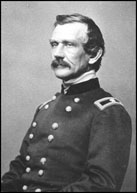Colonial Wars |
American Wars |
Link To This Page — Contact Us —
Major General Andrew A. Humphreys
 |
| NAME |
| Humphreys, Andrew Atkinson |
| BORN |
| November 2, 1810 Philadelphia, Pennsylvania |
| DIED |
| December 27, 1883 Washington, D.C. |
| ARMY |
| Union |
Humphreys was born to a family prominent in naval architecture. His grandfather, Joshua, designed the USS Constitution. He graduated from West Point in 1831, ranked 13 out of 33 in his class. He saw combat in the artillery in the Seminole Wars and then garrison duty. he resigned in 1836 to become a civil engineer for the government. Two years later, he was back in the army as a 1st lieutenant in the Topographical Engineers and worked on bridges, harbors, and coastal and railroad surveys. He spent much of the next 30 years as a civil engineer in the Army, with his service involving topographical and hydrological surveys of the Mississippi River Delta.
At the outbreak of the Civil War, H
mphreys was promoted to major and became the Chief Topographical Engineer for Major Gen. George B. McClellan's in the Army of the Potomac. Initially involved in planning the defenses of Washington, D.C., by March 1862, he shipped out with McClellan for the Peninsula Campaign. He was promoted to Brigadier General of volunteers and on September 12, assumed command of the new 3rd Division in the V Corps of the Army of the Potomac. He led the division at Antietam and Fredericksburg.
Although respected by his men for his bravery under fire, Humphreys was not well liked by them. In his mid-fifties, they considered him an old man, despite his relatively youthful appearance. His nickname was "Old Goggle Eyes" for his eyeglasses. He was a taskmaster and strict disciplinarian.
At Chancellorsville, his division did little, principally because most of his soldiers were near the ends of their enlistments.
On May 23, 1863, Humphreys was transferred to the command of the 2nd Division in the III Corps, under Major Gen. Daniel E. Sickles. When Meade assumed command of the Army of the Potomac, he asked Humphreys to be his Chief of Staff, replacing Brigadier Gen. Daniel Butterfield, who was considered to be too close politically to the previous commander, Major Gen. Joseph Hooker. He declined the opportunity to give up his division command.
Humphreys' new division immediately saw action at Gettysburg where, on July 2, Sickles insubordinately moved his corps from its assigned defensive position on Cemetery Ridge. Assaulted by the division of Major Gen. Lafayette McLaws, his 2 brigades were demolished. He put up the best fight that could have been expected and was eventually able to reform his survivors on Cemetery Ridge, but his division and the entire corps were finished as a fighting force.
Humphreys was promoted to major general of volunteers and finally acceded to Major Gen. George G. Meade's request to serve as his Chief of Staff because he did not have much of division left to command. He served in that position through the Bristoe Campaign, Mine Run Campaign , and the Overland Campaign and the siege of Petersburg in 1864. In November 1864, he assumed command of the II Corps, which he led for the rest of the siege and during the Appomattox Campaign. On March 13, 1865, he was brevetted Brigadier General in the Regular Army for his actions at Fredericksburg and Gettysburg, and then to major general for Sayler's Creek. He helped pursue Gen. Robert E. Lee to Appomattox Court House and was there for Lee's surrender.
After the war, Humphreys commanded the District of Pennsylvania. He became a permanent Brigadier General and Chief of Engineers from 1866-79. He retired on June 30, 1879, serving during this period on lighthouse and other engineering boards.
Humphreys studied philosophy and was one of the incorporators of the National Academy of Sciences. His published works were highlighted by his 1867 "Report on the Physics and Hydraulics of the Mississippi River," which gave him considerable prominence in the scientific community. He also wrote personal accounts of the war, "From Gettysburg to the Rapidan" and "The Virginia Campaign of '64 and '65"
He is buried at the Congressional Cemetery in Washington, D.C..
?
Promotions:
- Major- August 6, 1861
- Brigadier General USV- April 28, 1862
- Major General USV- July 8, 1863
- Brigadier General USA- March 13, 1865
- Major General USA- March ??, 1865
Major Commands:
- Chief Topographical Engineer, Army of the Potomac
- 3rd Division, V Corps, Army of the Potomac (September 12, 1862- January 27, 1863)
- 2nd Division, III Corps, Army of the Potomac (May 23- July 8, 1863)
- Chief of Staff, Major Gen. George Meade, Army of the Potomac
- II Corps (November 26, 1864- February 15, 1865; February 25- April 22, 1865; May 5,- June 9, 1865)
